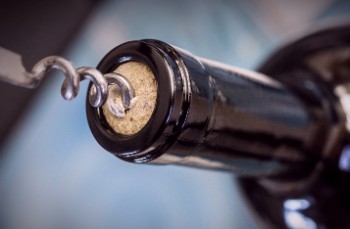Service Opening the Bottle
When opening a bottle of wine the bottle must not touch the table until all the glasses have been poured, and it should always be opened and poured in full view of the host unless there has been a request that it should be opened or decanted in advance of the guest’s arrival. In case of decanted wine, the empty bottle should be presented to the guest prior to bringing the decanted wine. Both should arrive on the cart in formal service, casual service allows for retrieval of the decanted wine after placing glasses on the table and presenting the bottle . It is not necessary to leave the empty bottle from a decanted wine at the table.
Once presented, the bottle should be held at eye level and within sight of the host. The bottle (still wines) should be kept vertical and held as close to motionless through the opening procedure.
Older wines, vintage ports etc with potentially fragile corks or high levels of sediment should be placed in a wine serving basket or held at maximum of 45 degrees from horizontal for the presentation and opening process.
Cut the capsule in two motions, at the lower ridge at the top ring of the bottle. A clean cut is desired and you should use the knife to remove the capsule top and place in your pocket. The knife of the corkscrew should be angled up against this glass ring so that a clean straight cut is obtained. The capsule should be placed in your pocket.
Formal Service requires cleaning the bottle top with a wipe of your serviette prior to inserting the corkscrew.
Casual Service suggests cleaning the bottle top with a wipe of your serviette prior to inserting the corkscrew..
NOTE for screwcaps or Stelvin enclosures. For screwcaps, break the seal of the enclosure beneath the cap by rotating the entire enclosure. Then hold the cap on the inside of your arm and roll the cap off into your hand in a smooth motion, pocketing the cap. The bottle should be kept vertical during this process. The label should remain facing the host as well.
 The tip of the corkscrew should be started just off center of the bottle, imagine an invisible live running inside the worm. That line should be aimed at the center of the bottle. Placing your hand on the worm and tilting the corkscrew is allowed to ensure accurate placement of the worm. Once inserted the worm should be returned to vertical to be inserted straight into the cork.
The tip of the corkscrew should be started just off center of the bottle, imagine an invisible live running inside the worm. That line should be aimed at the center of the bottle. Placing your hand on the worm and tilting the corkscrew is allowed to ensure accurate placement of the worm. Once inserted the worm should be returned to vertical to be inserted straight into the cork.
Corks vary in length, and so do worms although to a lesser degree. The worm should never be inserted to where it pushes through the bottom of the cork. While you may not know the length of the cork prior to opening, its safest to leave a full rotation on the worm when opening wines unless you know the cork is long and may be fragile.
Ah-so openers (butler’s friend) are not only better for old corks but are handy for standard service when used correctly. A slight tilt to the bottle is accepted when using this type of opener but it should be maintained through the entire opening process. An opener requiring two hands to open a bottle is not permitted in this service standard.
The cork should be removed slowly and steadily straight out of the bottle. A less than perfectly vertical extraction process increases the chance of breaking the cork dramatically. As the cork leaves the bottle, it can often be longer than the lever action of many openers. Using your hand to ease the cork out, while still attached to the opener is permitted. This can often allow you to prevent the undesired “pop” when the cork leaves the bottle.
Formal Service allows using an additional napkin/serviette to be used in place of making skin contact with the cork during its removal from the corkscrew. The cork is placed on the cork plate prior to cleaning the bottle top again with a wipe of your serviette. Having the inside corner of your serviette/napkin damp can help clean off mold that may be on and around the neck of the bottle.
Casual Service requires cleaning the bottle top with a wipe of your serviette/napkin. Use your bare hand to remove the cork from the worm.
- What is a sommelier
- Why to certify
- Prerequisites and Testing Criteria
- Wine List Creation
- Wine List Training
- Storage and Service Temperatures
- Introduction to Pairing and Components
- Pairing Concepts
- Service Intro and Presentation
- Service Opening the Bottle
- Sample and Pouring Order
- Sommelier Standards Sparkling Wine
- Sommelier Standards Beer Service
- Sommelier Certification Registration